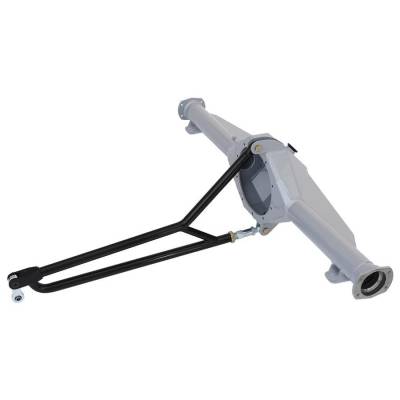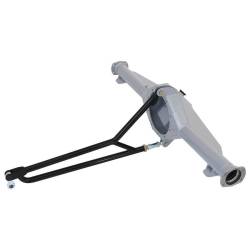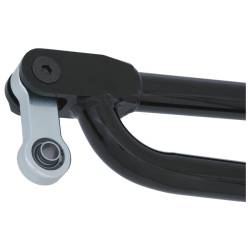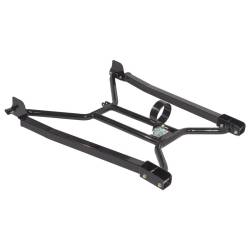64 - 70 Mustang - Torque Arm II, 33" Length
1964 - 1970 Mustang Torque Arm II, 33" length, adjustable for pinion angle
1964 - 1970 Mustang Torque Arm 33" length and bolts to FAB9 housing brackets or weld-on brackets (TCP-TABKT) when using existing rearend housing.
Sold as EACH
Special Notes
Ford Housing Torque Arm
The TCP Torque Arm is a bolt-on, pinion angle adjustable, traction device that can be used with our rear pushrod or factory leaf spring suspensions. Similar to traction bars, the arm converts torque to downward force at the tires, but has the benefit of providing improved traction during both straight line and cornering acceleration.
Installation is a direct bolt-on when used with our subframe connector system (?64-?70 Mustangs, ?67-?70 Cougars) and specific bolt-in FAB9? fabricated 9?? housing. Torque arms can also be installed on most Ford 9?? and 8?? equipped vehicles but, will require an additional weldin bracket kit (TCP-TABKT) and crossmember fabrication. A bolt-on welding fixture (TCP-TABKT-1) is also available to correctly position the mounting tabs.
How it Works
The arm is mounted at three points; a swiveling connection at the chassis, and two fixed mounts at the rear end housing. As torque is applied to the rear wheels, the arm (now fixed to the housing) rotates to push upward at the chassis mount while simultaneously pushing downward onto the wheels. Downward force creates additional traction that is equally distributed to each tire regardless of current body roll or suspension travel state. The arms rigid construction provides instant torque control. Leaf spring movement and bushing compliance are left available for ride quality and suspension control. As a result, throttle response and acceleration are immediate due to an increase in available traction and lack of leaf spring ??wrap-up,?? a common source of wheel hop
DogBone Spherical Bearing End Link
A torque arm can be solidly mounted to the housing but requires a floating chassis mount at the front of the arm. The rear end housing follows travel paths defined by the front leaf spring mounts or radius rods in a rear coil-over conversion. These paths or arcs affect both vehicle wheel base and rear axle alignment (roll steer). As a result, the chassis mount must allow fore/aft, rotational, and side-to-side movement to prevent binding. Traditional torque arm front mounting methods are subject to bushing and fastener wear and generally do not allow for side-to-side movement, relying on flexing of the arm to compensate for binding. For this reason a torque arm cannot be solidly mounted to the chassis. A unique DogBone end link was created to securely anchor the torque arm to the chassis crossmember. The DogBone features dual spherical bearings with high strength, wear resistant, Teflon? races. The bind-free mounting link enables the arm to act against vertical loading with movement in all directions for suspension travel, body roll, and roll steer.
Construction
The torque arm is constructed from 1-1/4?? x .156 wall, round tubing. The design features an angled tubular brace to minimize flex at the underbody clearance bend of the upper tube. Tubes and billet end mounts are spray arc welded for maximum weld penetration. A strong yet ductile structure is created to safely withstand continuous bending forces. The torque arm and all supporting hardware are powder coated or zinc plated for corrosion resistance.
Pinion Angle
Correct pinion angle during acceleration is key to eliminating unwanted vibrations and additional friction caused by misaligned drivetrain components. The addition of a torque arm provides significant pinion angle related benefits. The range of dynamic pinion anlge change is greatly reduced from acceleration to deceleration. Also, a means to precisely adjust pinion angle is enabled. Only 1-1/2 to 2 degrees of negative pinion angle is required versus 4 to 7 degrees when relying on leaf springs for torque control. The drive line remains closer to its ideal, most efficient position at all times. A doubleadjustment coupler located along the lower arm tube provides a simple means of precise pinion angle adjustment within a 6-1/2 degree range.
Details
- TCP-TA2F9-33
- TCP-TA2F9-33
- Total Control Products
- New
Categories
Shipping Information
- Item Requires Shipping
- FREE SHIPPING on orders *$199 or more
Customer Reviews
 Total Reviews (0)
Total Reviews (0)
You must login to post a review.
















Write the First Review!